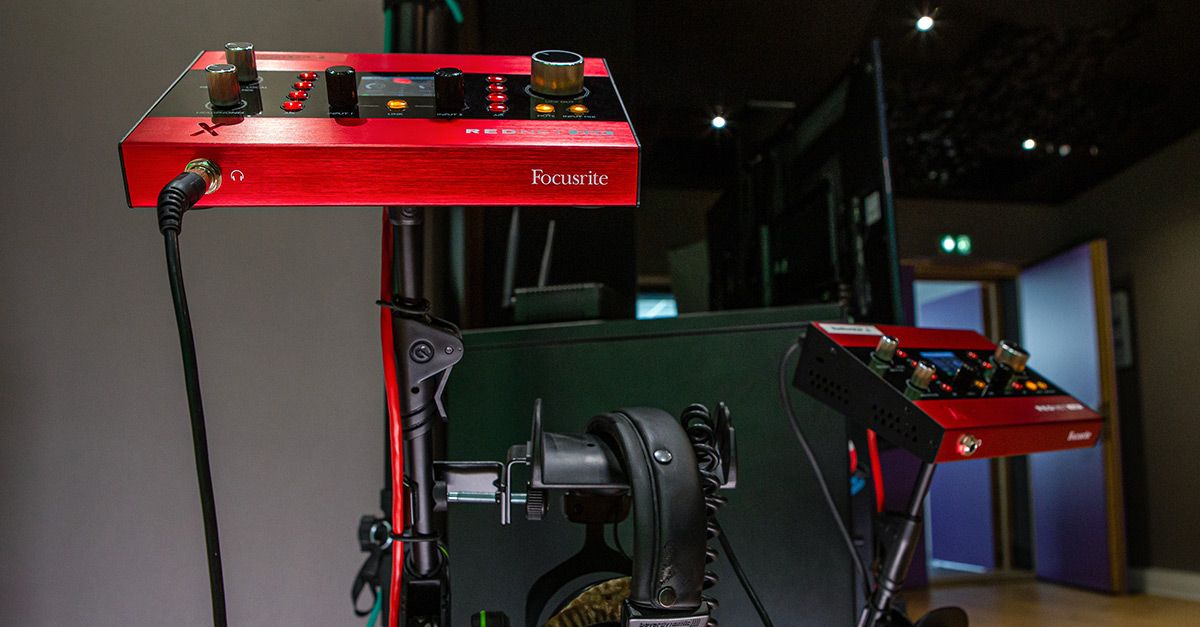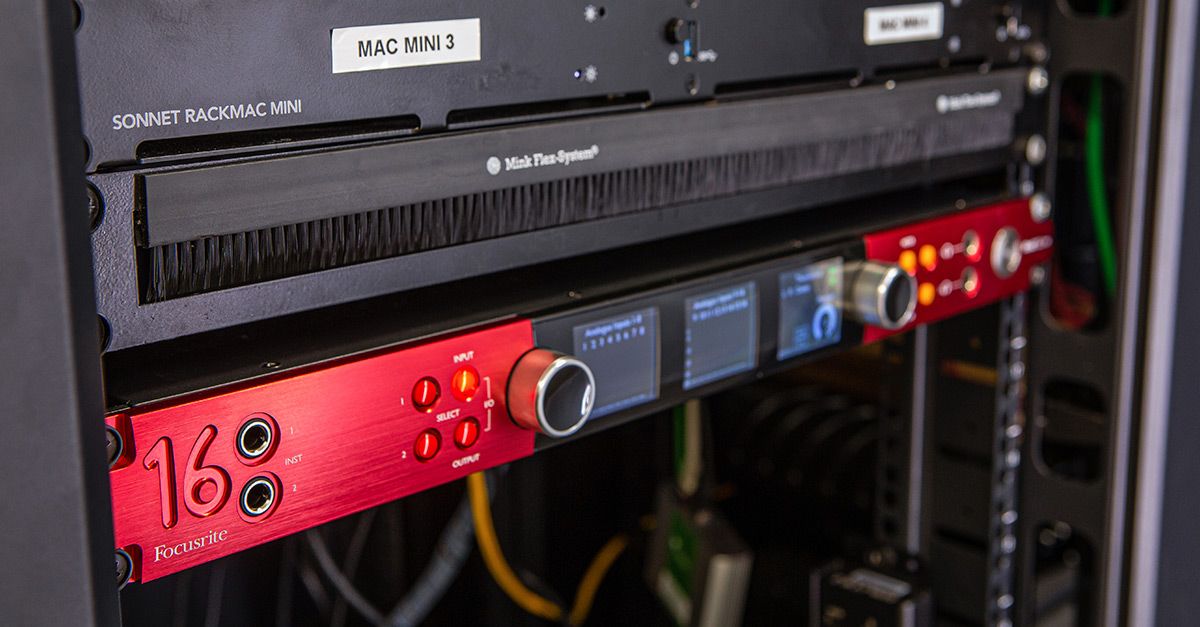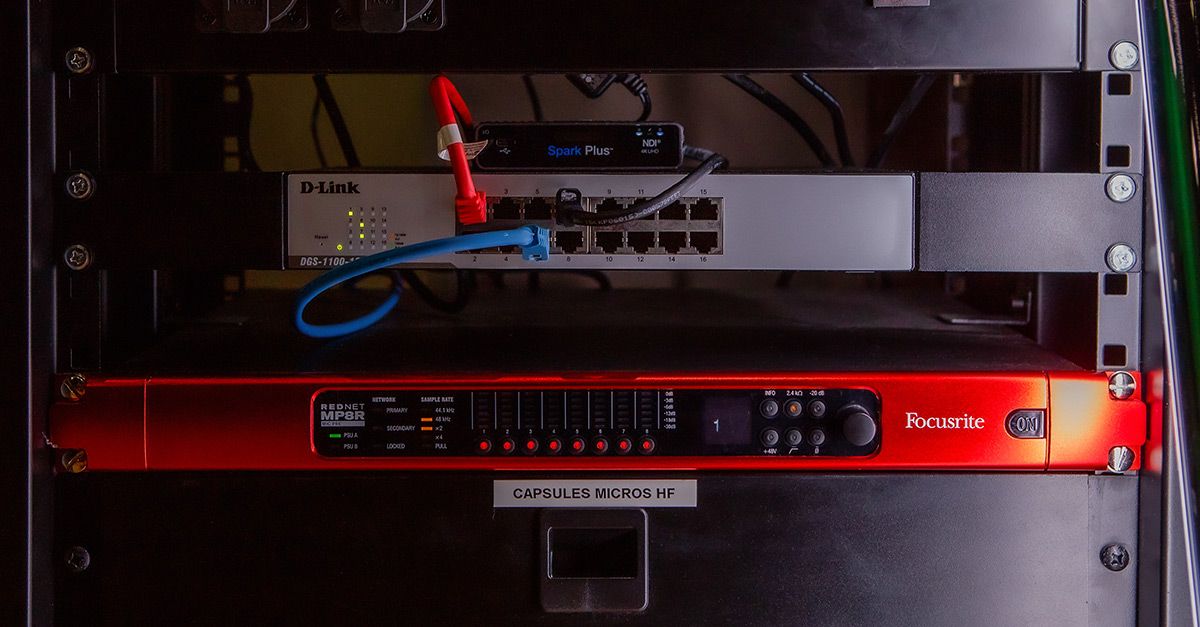Product News
G4F Puts Focusrite At The Heart Of Gaming Audio
2022.02.23

G4F
Located in the city of Angoulême in the Bordeaux region of France, G4F is one of Europe's premier gaming audio production houses. Game developers, both major and minor, come to G4F to take advantage of some of the most highly skilled and experienced game audio professionals the business has to offer. With Focusrite RedNet hardware used throughout G4F's multi-studio facility, everything that the sound of a game might require, from foley and sound effect creation, music composition, recording, editing, mixing and mastering, to multi-language dialogue recording, editing and syncing, can be accomplished in one place.
G4F founder and creative lead, Vincent Percevault, explains the background, “Our clients and their projects demand expertise, speed, flexibility and highly collaborative workflows. We had previously relied on MADI-compatible hardware to give us the ability to connect digitally across our rooms over long cable distances, but the arrival of the first Dante-equipped RedNet products in 2018 demonstrated very quickly how RedNet could offer a vastly more versatile and capable solution over our existing gigabit network."

The eight studios at G4F comprise three Dolby Atmos equipped edit/mix rooms (Studios A, B and H), three audio and sound design suites (Studios D, E and G), and two audio recording spaces (Studios C and F) that can handle everything from music, dialogue and foley recording to facial motion capture for syncing multi-language dialogue to game character animation. G4F in-house creative staff number around twelve, supported by a roster of visiting freelancers.
Being very much a facility built on a network model, twin Mac and twin PC computing power is centralised and available to all the network connected rooms, however Studios A and B additionally benefit from dedicated local Mac Pros. Multipoint KVM (keyboard, video display, mouse) hardware in Studios C to H, connected via a dedicated network, enables remote DAW operation so users can effectively take control of any studio room from any workstation.
In terms of the hardware installed in each studio, the nature of AoIP and Dante to a great extent tears down the walls and enables every item of RedNet hardware to be effectively available to any studio, however the basic inventory and architecture of equipment installed in each G4F studio is described in the following paragraphs and illustrated in the accompanying schematic.

A Tour Of The Studios
G4F's eight studios have a plethora of equipment to achieve their specific tasks.

Studio A
The main 7.1.4 Dolby Atmos mix room. This comprises:
- A Mac Pro running Pro Tools HD and Nuendo
- A RedNet R1 Desktop Remote Controller
- A Red 8Line 58-input, 64-output, Thunderbolt™ 3 interface
- A RedNet D16R MkII 16x16 AES3 digital I/O interface.
The Red 8Line provides Dante, DigiLink, ADAT and S/PDIF connectivity to and from the local Mac and digital audio sources, while the RedNet D16R MkII, along with providing external level control, converts the Dante network audio to AES3 format for downstream Trinnov Altitude 32 room acoustics optimisation and Focal monitors preamplification. Looking ahead, the next upgrade in Studio A is likely to be the extension of RedNet AoIP through to the monitor preamp.
Studio B
Another multi-channel Dolby Atmos mix facility, but based on 5.1.2 architecture. This comprises:
- A Mac Pro and Pro Tools HD and Nuendo with 5.1.2
- A RedNet R1 Controller
- A Red 8Line interface
- A RedNet A16R MkII analogue I/O interface.
The RedNet A16R directly drives the Studio B 5.1.2 monitoring system. As with Studio A, it is planned that a further Trinnov room optimisation monitor preamp will be incorporated and connected to the Dante AoIP network.
Studio C
This studio is dedicated primarily to audio recording. It comprises:
Two RedNet X2P Dante interfaces, each of which offers 2x2 analogue I/O supported by a high power and very high-performance headphone amplifier.
The mic inputs fitted to the X2P incorporate the acclaimed Focusrite Air mode that emulates the sound of classic input transformer-equipped hardware.

Studio D
Studio D is based on the X2P 2x2 interface but this time the studio is specifically targeted towards audio post-production and editing.
Studio E
This studio is aimed at audio-visual editing work and comprises:
- A RedNet X2P
- A RedNet AM2 Dante stereo line out and headphone amplifier
Studio F
This is the primary recording stage at G4F. It comprises:
• Two RedNet X2P 2x2 interfaces
• A RedNet AM2 Dante stereo line out
• A RedNet MP8R 8 channel remote controlled mic preamp.
The RedNet hardware combined provides twelve mic inputs, and the two X2P and single AM2 provide three independent headphone monitoring feeds, each of which can carry a different monitor mix. The X2P interfaces offer options of direct input or network derived monitoring feeds and, Vincent says, it's a testament to the extremely low-latency Dante and RedNet network that musicians and performers hardly ever choose the direct input monitoring option.
Studio G
This studio is primarily aimed at sound design and sound effect creation and requires only a relatively simple setup. It has a single RedNet X2P that provides the two input and two output channels necessary.
Studio H
This studio is also a multi-channel 5.1.2 Dolby Atmos mix facility. It comprises:
- A Red16 Line
- A RedNet R1 controller
- A RedNet A16R MkII analogue I/O interface.
As in Studio B, the RedNet A16R directly drives the 5.1.2 monitoring system.

Streamlining Workflow With RedNet
The RedNet R1, that features in Studios A, B and H, is the most recent RedNet addition at G4F and, says Vincent, its functionality and capabilities have significantly streamlined workflows at G4F, and massively enriched the extent and variety of what's feasible. In basic terms, the RedNet R1 is a Dante AoIP equipped monitor controller, but its features also extend to configuration and management of RedNet sources, outputs, systems, and sessions. And, of course, being an AoIP device itself, the RedNet R1 is agnostic in terms of the location of the hardware and session under control. It might be based in the same room, the room next door, the room along the corridor, or in a completely different building. Or all of those at the same time.
“The RedNet R1… has significantly streamlined workflows at G4F, and massively enriched the extent and variety of what's feasible." — Vincent Percevault
This level of versatility and deep system control dovetails into the needs at G4F for the rapid implementation of complex multi-channel, multimedia sessions. The RedNet R1 also provides a hardware control alternative to many of the commonly used features in the Focusrite RedNet Control software app, and as such, provides the intuitive immediacy of buttons, rotary knobs and displays that keyboard, mouse and pointer interfaces lack for some users.

In more specific terms, the RedNet R1 offers control of monitor output systems ranging from mono to 7.1.4 multi-channel and includes Dolby Atmos. Alternatively, non-standard configurations of up to twelve outputs can be created for custom monitor systems: bespoke object-oriented mixes for example. The R1 can be used to control and route groups of outputs from multiple RedNet sources, analogue inputs and outputs, ADAT and S/PDIF connections, and from an entire Dante AoIP network, all simultaneously and interchangeably. RedNet R1 top-panel hardware controls include level, reference level, preset selection, cut, dim, mute and a variety of solo modes. There's also A/B functionality for switching between multiple monitoring presets and up to four fold-down presets that enable quick downmixed performance and compatibility checks.
Finally, the RedNet R1 features a high-quality headphone amplifier and Dante enabled talkback with options of an internal mic or a phantom power equipped XLR input — although in Vincent's opinion, the internal talkback mic works so well and sounds so good that the external mic input option is often superfluous.
“The internal talkback mic works so well and sounds so good that the external mic input option is often superfluous." — Vincent Percevault
A Solution That Grows With The Industry

The growing popularity of gaming, particularly throughout the global pandemic and lockdowns, has accelerated the audio ambitions of contemporary games designers. It's a growth of ambition that's driven partly by the kind of multi-channel, immersive creation and production possibilities made possible at G4F through RedNet. Immersive, object-oriented audio, such as Dolby Atmos, in games had a relatively slow start, but more recently it has become a significant part of the experience. This in turn feeds back to game designers and inspires yet further ambition. In creative terms it's a virtuous circle, but it demands rapidly advancing technical capabilities and versatility in audio production. And that plays perfectly to the strengths of RedNet and AoIP where complex and very low latency signal routing is made simple, and where system expansion is as easy as, for example, plugging a network cable into the rear panel of a box that offers another, say, sixteen easily configurable input or output channels.
For many audio professionals however, AoIP, Dante and RedNet still constitute a completely new way of working that presents some challenges of education and familiarity. “There's a learning curve for sure", says Vincent, “but we find people grasp the principles pretty quickly, and although mistakes can be made, they tend to be similar each time so are easy to fix. Most often, if something goes wrong, we find either the network clocking or routing configuration needs a simple tweak, and then things run really smoothly. One of the benefits of the RedNet R1 is that it adds a layer of intuitive hardware control over the RedNet Control and Dante Controller apps, and that really helps us work more instinctively and creatively."
But, says Vincent, “the real magic of Dante and RedNet is that we can take control of any workstation from any room, and route multiple audio channels, live or recorded, with effectively no latency, to wherever it's needed. It's a workflow capability that would have been unimaginable only, say, ten years ago, but Dante and RedNet make it easy".
